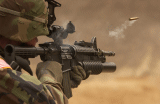
, nation
s, or other parties typified by extreme aggression
, social
disruption, and usually high mortality. War should be understood as an actual, intentional and widespread armed conflict between political communities, and therefore is defined as a form of political violence
. The set of techniques used by a group to carry out war is known as warfare.
War is not a pathology that, with proper hygiene and treatment, can be wholly prevented. War is a natural condition of the State, which was organized in order to be an effective instrument of violence on behalf of society. Wars are like deaths, which, while they can be postponed, will come when they will come and cannot be finally avoided. ![]()
War is a quarrel between two thieves too cowardly to fight their own battle; therefore they take boys from one village and another village, stick them into uniforms, equip them with guns, and let them loose like wild beasts against each other.![]()
War will never yield but to the principles of universal justice and love, and these have no sure root but in the religion of Jesus Christ.![]()
War is fought by human beings. ![]()
War is a continuation of politics by other means. ![]()
To jaw-jaw is better than to war-war.![]()

